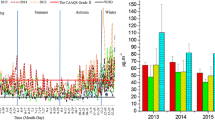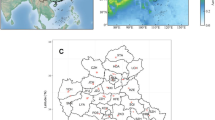Abstract
The quantitative assessment of the spatial and temporal variability and drivers of fine particulate matter (PM2.5) fraction concentrations are important for pollution control and public health preservation in China. In this study, we investigated the spatial temporal variation of PM2.5 chemical component based on the PM2.5 chemical component datasets from 2000 to 2019 and revealed the driving forces of the differences in the spatial distribution using geodetector model (GD), multi-scale geographically weighted regression model (MGWR), and a two-step clustering approach. The results show that: the PM2.5 chemical fraction concentrations show a trend of first increasing (2000–2007) and then decreasing (2007–2019). From 2000 to 2019, the change rates of PM2.5, organic matter (OM), black carbon (BC), sulfates (SO2– 4), ammonium (NH+ 4), and nitrates (NO– 3) were −0.59, −0.23, −0.07, −0.15, −0.02, and 0.04μg/m3/yr in the entirety of China. The secondary aerosol (i.e., SO2− 4, NO− 3, and NH+ 4; SNA) had the highest fraction in PM2.5 concentrations (55.6–68.1% in different provinces), followed by OM and BC. Spatially, North, Central, and East China are the regions with the highest PM2.5 chemical component concentrations in China; meanwhile, they are also the regions with the most significant decrease in PM2.5 chemical fraction concentrations. The GD and MGWR model shows that among all variables, the number of enterprises, disposable income, private car ownership, and the share of secondary industry non-linearly enhance the differences in the spatial distribution of PM2.5 component concentrations. Electricity consumption has the strongest influence on NH+ 4 emissions in Northwest China and BC and OM emissions in Northeast China.









Similar content being viewed by others
Data availability
The data used to support the results of this research are shown in the manuscript and available from the corresponding author upon request.
References
Apte JS, Brauer M, Cohen AJ et al (2018) Ambient PM2.5 reduces global and regional life expectancy. Environ Sci Technol Lett 5:546–551
Chen Z, Chen D, Zhao C et al (2020) Influence of meteorological conditions on PM2.5 concentrations across China: a review of methodology and mechanism. Environ Int 139:105558
Cheng Z, Luo L, Wang S et al (2016) Status and characteristics of ambient PM2.5 pollution in global megacities. Environ Int 89:212–221
Cheng J, Tong D, Zhang Q, Liu Y et al (2021) Pathways of China’s PM2.5 air quality 2015–2060 in the context of carbon neutrality. Natl Sci Rev 8(12):nwab078
Cohen AJ, Brauer M, Burnett R et al (2017) Estimates and 25-year trends of the global burden of disease attributable to ambient air pollution: an analysis of data from the Global Burden of Diseases Study 2015. Lancet 389:1907–1918
Feng Z, Hu E, Wang X et al (2015) Ground-level O3 pollution and its impacts on food crops in China: a review. Environ Pollut 199:42–48
Fotheringham AS, Yang W, Kang W (2017) Multiscale geographically weighted regression (MGWR). Ann Am Assoc Geogr 107:1247–1265
Geng G, Zhang Q, Tong D et al (2017) Chemical composition of ambient PM2.5 over China and relationship to precursor emissions during 2005-2012. Atmos Chem Phys 17:9187–9203
Geng G, Xiao Q, Liu S et al (2021) Tracking air pollution in China: near real-time PM2.5 retrievals from multisource data fusion. Environ Sci Technol 55:12106–12115
Gong X, Hong S, Jaffe DA (2018) Ozone in China: spatial distribution and leading meteorological factors controlling O3 in 16 Chinese cities. Aerosol Air Qual Res 18:2287–2300
Guo H, Cheng T, Gu X et al (2017) Assessment of PM2.5 concentrations and exposure throughout China using ground observations. Sci Total Environ 601:1024–1030
Han YJ, Kim SR, Jung JH (2011) Long-term measurements of atmospheric PM 2.5 and its chemical composition in rural Korea. J Atmos Chem 68:281–298
He J, Gong S, Yu Y et al (2017) Air pollution characteristics and their relation to meteorological conditions during 2014–2015 in major Chinese cities. Environ Pollut 223:484–496
He G, Pan Y, Tanaka T (2020) The short-term impacts of COVID-19 lockdown on urban air pollution in China. Nat Sustain 3(12):1005–1011
He C, Hong S, Zhang L et al (2021) Global, continental, and national variation in PM2.5, O3, and NO2 concentrations during the early 2020 COVID-19 lockdown. Atmos Pollut Res 12(3):136–145
Jbaily A, Zhou X, Liu J et al (2022) Air pollution exposure disparities across US population and income groups. Nature 601:228–233
Jin Q, Fang X, Wen B et al (2017) Spatio-temporal variations of PM2.5 emission in China from 2005 to 2014. Chemosphere 183:429–436
Lelieveld J, Evans JS, Fnais M et al (2015) The contribution of outdoor air pollution sources to premature mortality on a global scale. Nature 525:367–371
Li D, Zhao Y, Wu R et al (2019) Spatiotemporal features and socioeconomic drivers of PM2.5 concentrations in China. Sustain 11:1201
Liang X, Li S, Zhang S et al (2016) PM2.5 data reliability, consistency, and air quality assessment in five Chinese cities. J Geophys Res 121:10220–10236
Liang Z, Zhao X, Chen J et al (2019) Seasonal characteristics of chemical compositions and sources identification of PM 2.5 in Zhuhai, China. Environ Geochem Health 41:715–728
Liu Y, Paciorek CJ, Koutrakis P (2009) Estimating regional spatial and temporal variability of PM2.5 concentrations using satellite data, meteorology, and land use information. Environ Health Perspect 117:886–892
Liu Z, Gao W, Yu Y et al (2018) Characteristics of PM2.5 mass concentrations and chemical species in urban and background areas of China: emerging results from the CARE-China network. Atmos Chem Phys 18:8849–8871
Liu K, Qiao Y, Zhou Q (2021) Analysis of China’s industrial green development efficiency and driving factors: research based on MGWR. Int J Environ Res Public Health 18:3960
Liu S, Geng G, Xiao Q et al (2022) Tracking daily concentrations of PM2.5 chemical composition in China since 2000. Environ Sci Technol 56:16517–16527
Ma Z, Liu R, Liu Y, Bi J (2019) Effects of air pollution control policies on PM2.5 pollution improvement in China from 2005 to 2017: a satellite-based perspective. Atmos Chem Phys 19:6861–6877
Ming L, Jin L, Li J et al (2017) PM2.5 in the Yangtze River Delta, China: chemical compositions, seasonal variations, and regional pollution events. Environ Pollut 223:200–212
Oshan TM, Li Z, Kang W et al (2019) MGWR: a python implementation of multiscale geographically weighted regression for investigating process spatial heterogeneity and scale. ISPRS Int J Geo Inf 8:269
Ou S, Wei W, Cai B et al (2022) Exploring the causes for co-pollution of O3 and PM2.5 in summer over North China. Environ Monit Assess 194:289. https://doi.org/10.1007/s10661-022-09951-4
Partal T, Kahya E (2006) Trend analysis in Turkish precipitation data. Hydrol Process 20:2011–2026
Qin H, Huang Q, Zhang Z et al (2019) Carbon dioxide emission driving factors analysis and policy implications of Chinese cities: combining geographically weighted regression with two-step cluster. Sci Total Environ 684:413–424
Sun YL, Wang ZF, Du W et al (2015) Long-term real-time measurements of aerosol particle composition in Beijing, China: seasonal variations, meteorological effects, and source analysis. Atmos Chem Phys 15:10149–10165
Tran DX, Pearson D, Palmer A et al (2022) Quantifying spatial non-stationarity in the relationship between landscape structure and the provision of ecosystem services: an example in the New Zealand hill country. Sci Total Environ 808:152126
Wang JF, Zhang TL, Fu BJ (2016) A measure of spatial stratified heterogeneity. Ecol Indic 67:250–256
Wang X, Tian G, Yang D et al (2018) Responses of PM2.5 pollution to urbanization in China. Energy Policy 123:602–610
Wang S, Xu L, Ge S et al (2020) Driving force heterogeneity of urban PM2.5 pollution: evidence from the Yangtze River Delta, China. Ecol Indic 113:106210
Wei J, Li Z, Lyapustin A et al (2021) Reconstructing 1-km-resolution high-quality PM2.5 data records from 2000 to 2018 in China: spatiotemporal variations and policy implications. Remote Sens Environ 252:112136
Xiao Q, Geng G, Cheng J et al (2021) Evaluation of gap-filling approaches in satellite-based daily PM2.5 prediction models. Atmos Environ 244:117921
Xu B, Lin B (2016) Regional differences of pollution emissions in China: contributing factors and mitigation strategies. J Clean Prod 112:1454–1463
Xu H, Jia Y, Sun Z et al (2022) Environmental pollution, a hidden culprit for health issues. Eco-Environment & Health 1(1):31–45
Yang H, Yao R, Sun P et al (2023) Spatiotemporal evolution and driving forces of PM2.5 in urban agglomerations in China. Int J Environ Res Public Health 20:2316
Yu FW, Chan KT (2012) Using cluster and multivariate analyses to appraise the operating performance of a chiller system serving an institutional building. Energy Build 44:104–113
Zhao H, Gui K, Ma Y et al (2022) Multi-year variation of ozone and particulate matter in Northeast China based on the Tracking Air Pollution in China (TAP) data. Int J Environ Res Public Health 19:3830
Zheng Y, Wen X, Bian J et al (2021) Associations between the chemical composition of PM2.5 and gestational diabetes mellitus. Environ Res 198:110470
Funding
The research leading to these results received funding from the Hubei Provincial Natural Science Foundation of China (2021CFB112).
Author information
Authors and Affiliations
Contributions
Chao He and Jiming Jin: conceptualization, methodology, software, data curation, writing original draft and editing, and supervision. Bin Li and Lu Zhang: visualization and investigation. Lijun Liu and Xusheng Gong: writing—review and editing. Haiyan Li: software and validation.
Corresponding author
Ethics declarations
Ethics approval
Not applicable.
Consent to participate
All authors agree to participate.
Consent for publication
All authors agree to the publication.
Competing interests
The authors declare no competing interests.
Additional information
Responsible Editor: Gerhard Lammel
Publisher’s note
Springer Nature remains neutral with regard to jurisdictional claims in published maps and institutional affiliations.
Supplementary information
ESM 1
(DOCX 299 kb)
Rights and permissions
Springer Nature or its licensor (e.g. a society or other partner) holds exclusive rights to this article under a publishing agreement with the author(s) or other rightsholder(s); author self-archiving of the accepted manuscript version of this article is solely governed by the terms of such publishing agreement and applicable law.
About this article
Cite this article
He, ., Li, B., Gong, X. et al. Spatial-temporal evolution patterns and drivers of PM2.5 chemical fraction concentrations in China over the past 20 years. Environ Sci Pollut Res 30, 91839–91852 (2023). https://doi.org/10.1007/s11356-023-28913-y
Received:
Accepted:
Published:
Issue Date:
DOI: https://doi.org/10.1007/s11356-023-28913-y




